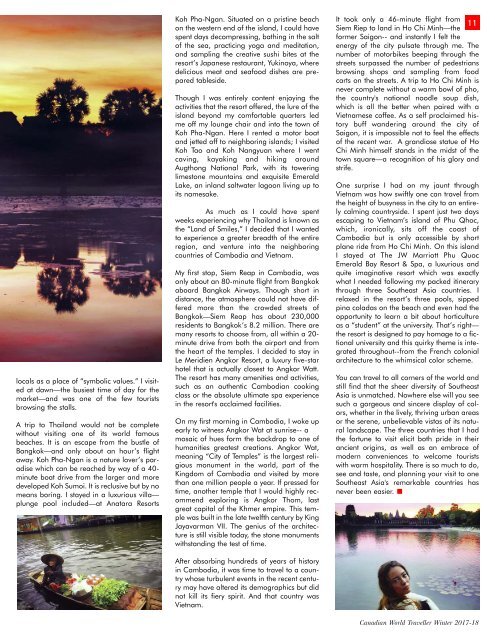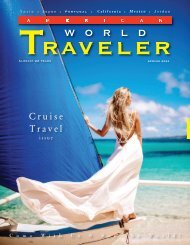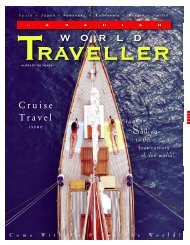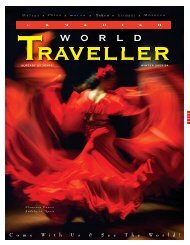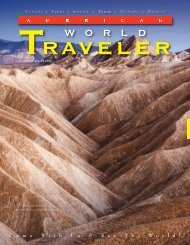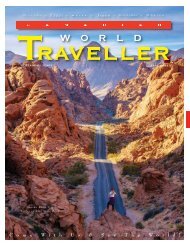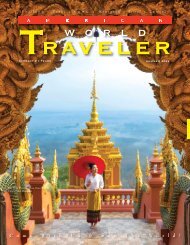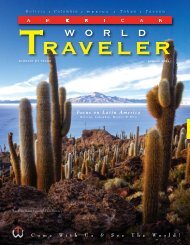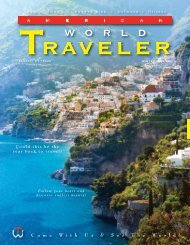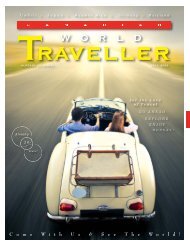Canadian World traveller Winter 2017-18 Issue
Now in our 15th year of publishing, Canadian World Traveller explores the culture and history of worldwide destinations, sharing the adventure of discovery with our readers and motivating them to make their travel dreams a reality. Published quarterly, CWT helps sophisticated, independent Canadian travellers choose their next destination by offering a lively blend of intelligent, informative articles and tantalizing photographic images from our World’s best destinations, cruises, accommodations and activities to suit every traveller's taste.
Now in our 15th year of publishing, Canadian World Traveller explores the culture and history of worldwide destinations, sharing the adventure of discovery with our readers and motivating them to make their travel dreams a reality. Published quarterly, CWT helps sophisticated, independent Canadian travellers choose their next destination by offering a lively blend of intelligent, informative articles and tantalizing photographic images from our World’s best destinations, cruises, accommodations and activities to suit every traveller's taste.
Create successful ePaper yourself
Turn your PDF publications into a flip-book with our unique Google optimized e-Paper software.
locals as a place of “symbolic values.” I visited<br />
at dawn—the busiest time of day for the<br />
market—and was one of the few tourists<br />
browsing the stalls.<br />
A trip to Thailand would not be complete<br />
without visiting one of its world famous<br />
beaches. It is an escape from the bustle of<br />
Bangkok—and only about an hour’s flight<br />
away. Koh Pha-Ngan is a nature lover’s paradise<br />
which can be reached by way of a 40-<br />
minute boat drive from the larger and more<br />
developed Koh Sumoi. It is reclusive but by no<br />
means boring. I stayed in a luxurious villa—<br />
plunge pool included—at Anatara Resorts<br />
Koh Pha-Ngan. Situated on a pristine beach<br />
on the western end of the island, I could have<br />
spent days decompressing, bathing in the salt<br />
of the sea, practicing yoga and meditation,<br />
and sampling the creative sushi bites at the<br />
resort’s Japanese restaurant, Yukinoya, where<br />
delicious meat and seafood dishes are prepared<br />
tableside.<br />
Though I was entirely content enjoying the<br />
activities that the resort offered, the lure of the<br />
island beyond my comfortable quarters led<br />
me off my lounge chair and into the town of<br />
Koh Pha-Ngan. Here I rented a motor boat<br />
and jetted off to neighboring islands; I visited<br />
Koh Tao and Koh Nangyuan where I went<br />
caving, kayaking and hiking around<br />
Augthong National Park, with its towering<br />
limestone mountains and exquisite Emerald<br />
Lake, an inland saltwater lagoon living up to<br />
its namesake.<br />
As much as I could have spent<br />
weeks experiencing why Thailand is known as<br />
the “Land of Smiles,” I decided that I wanted<br />
to experience a greater breadth of the entire<br />
region, and venture into the neighboring<br />
countries of Cambodia and Vietnam.<br />
My first stop, Siem Reap in Cambodia, was<br />
only about an 80-minute flight from Bangkok<br />
aboard Bangkok Airways. Though short in<br />
distance, the atmosphere could not have differed<br />
more than the crowded streets of<br />
Bangkok—Siem Reap has about 230,000<br />
residents to Bangkok’s 8.2 million. There are<br />
many resorts to choose from, all within a 20-<br />
minute drive from both the airport and from<br />
the heart of the temples. I decided to stay in<br />
Le Meridien Angkor Resort, a luxury five-star<br />
hotel that is actually closest to Angkor Watt.<br />
The resort has many amenities and activities,<br />
such as an authentic Cambodian cooking<br />
class or the absolute ultimate spa experience<br />
in the resort's acclaimed facilities.<br />
On my first morning in Cambodia, I woke up<br />
early to witness Angkor Wat at sunrise-- a<br />
mosaic of hues form the backdrop to one of<br />
humanities greatest creations. Angkor Wat,<br />
meaning “City of Temples” is the largest religious<br />
monument in the world, part of the<br />
Kingdom of Cambodia and visited by more<br />
than one million people a year. If pressed for<br />
time, another temple that I would highly recommend<br />
exploring is Angkor Thom, last<br />
great capital of the Khmer empire. This temple<br />
was built in the late twelfth century by King<br />
Jayavarman VII. The genius of the architecture<br />
is still visible today, the stone monuments<br />
withstanding the test of time.<br />
After absorbing hundreds of years of history<br />
in Cambodia, it was time to travel to a country<br />
whose turbulent events in the recent century<br />
may have altered its demographics but did<br />
not kill its fiery spirit. And that country was<br />
Vietnam.<br />
11<br />
It took only a 46-minute flight from<br />
Siem Riep to land in Ho Chi Minh—the<br />
former Saigon-- and instantly I felt the<br />
energy of the city pulsate through me. The<br />
number of motorbikes beeping through the<br />
streets surpassed the number of pedestrians<br />
browsing shops and sampling from food<br />
carts on the streets. A trip to Ho Chi Minh is<br />
never complete without a warm bowl of pho,<br />
the country's national noodle soup dish,<br />
which is all the better when paired with a<br />
Vietnamese coffee. As a self proclaimed history<br />
buff wandering around the city of<br />
Saigon, it is impossible not to feel the effects<br />
of the recent war. A grandiose statue of Ho<br />
Chi Minh himself stands in the midst of the<br />
town square—a recognition of his glory and<br />
strife.<br />
One surprise I had on my jaunt through<br />
Vietnam was how swiftly one can travel from<br />
the height of busyness in the city to an entirely<br />
calming countryside. I spent just two days<br />
escaping to Vietnam’s island of Phu Qhoc,<br />
which, ironically, sits off the coast of<br />
Cambodia but is only accessible by short<br />
plane ride from Ho Chi Minh. On this island<br />
I stayed at The JW Marriott Phu Quoc<br />
Emerald Bay Resort & Spa, a luxurious and<br />
quite imaginative resort which was exactly<br />
what I needed following my packed itinerary<br />
through three Southeast Asia countries. I<br />
relaxed in the resort’s three pools, sipped<br />
pina coladas on the beach and even had the<br />
opportunity to learn a bit about horticulture<br />
as a “student” at the university. That’s right—<br />
the resort is designed to pay homage to a fictional<br />
university and this quirky theme is integrated<br />
throughout--from the French colonial<br />
architecture to the whimsical color scheme.<br />
You can travel to all corners of the world and<br />
still find that the sheer diversity of Southeast<br />
Asia is unmatched. Nowhere else will you see<br />
such a gorgeous and sincere display of colors,<br />
whether in the lively, thriving urban areas<br />
or the serene, unbelievable vistas of its natural<br />
landscape. The three countries that I had<br />
the fortune to visit elicit both pride in their<br />
ancient origins, as well as an embrace of<br />
modern conveniences to welcome tourists<br />
with warm hospitality. There is so much to do,<br />
see and taste, and planning your visit to one<br />
Southeast Asia's remarkable countries has<br />
never been easier.<br />
<strong>Canadian</strong> <strong>World</strong> Traveller <strong>Winter</strong> <strong>2017</strong>-<strong>18</strong>


